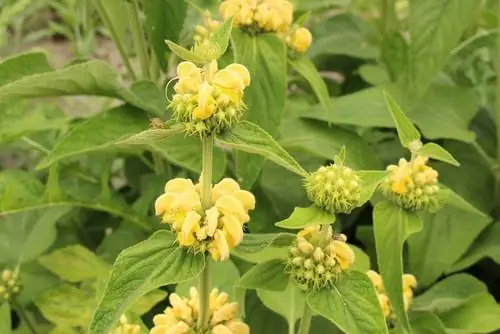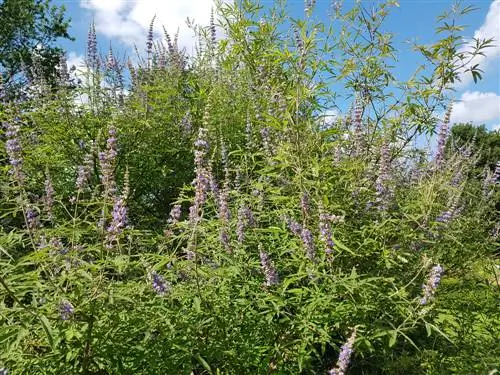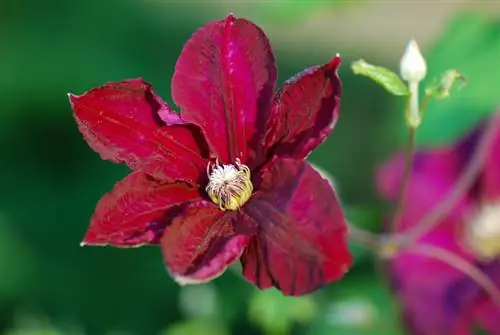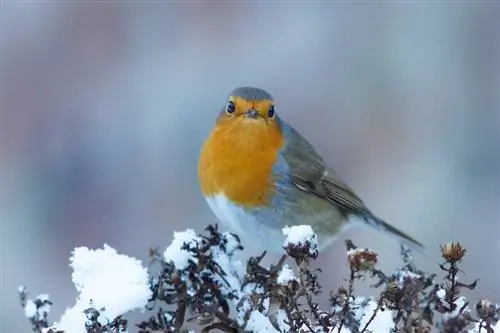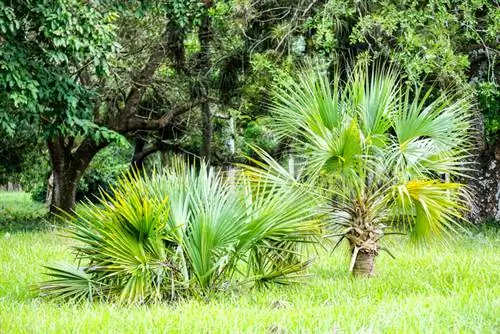- Author admin [email protected].
- Public 2023-12-16 16:46.
- Last modified 2025-01-23 11:21.
The Syrian firewort (Phlomis russeliana), also known as golden whorl because of the characteristic shape of its whorled flowers, is quite insensitive to drought and is therefore ideal for steppe and gravel gardens. The perennial is also robust, easy to care for, long-lasting and adapts easily to many garden locations.
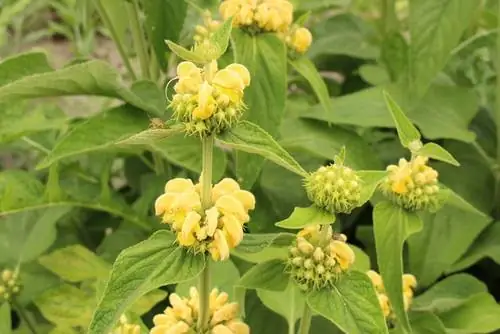
What characterizes the Syrian burnt herb?
The Syrian fireweed (Phlomis russeliana) is a robust, long-lasting and easy-care perennial that is suitable for steppe, gravel and rock gardens. It impresses with its distinctive shape, bright golden yellow flowers and resistance to drought.
Origin and distribution
The Syrian fireweed (bot. Phlomis russeliana), popular in many gardens, also called golden whorl or after its discoverer, the Scottish naturalist Dr. Alexander Russell, called Russel's Burnweed, is one of at least 100 different species of burnweed. The species-rich genus, which belongs to the mint family (Lamiaceae), includes both perennials and subshrubs. The homeland of most species extends from southeastern Europe across the entire Central Asian continent to China. The Syrian burnweed originally comes from the mountainous forest regions of northern Anatolia.
Here it can be found wild in both coniferous and deciduous forests as well as on bare areas, preferably in association with hazelnut bushes. The sun-loving perennial grows particularly well on the edges of trees, in open spaces and prefers dry or rocky substrates.
Usage
Fire herbs can fit into many garden environments and look good on tree edges, on embankments, in rock gardens and in prairie beds. A dry subsoil and root competition do not affect the robust plant, which is why it can be used in a variety of ways. Due to its striking growth and the height of between 90 and 150 centimeters - depending on the species and variety chosen - it is best to plant the strong perennials in the middle of the bed, where they go well with perennials such as the mullein (bot. Verbascum), the blue rue (Perovskia), cranesbill (Geranium), steppe sage (Salvia nemorosa), germander (Teucrium), lavender (Lavandula) or various ornamental grasses. The bright golden yellow blooming Syrian fireweed harmonizes particularly well with blue or violet flowering species.
Appearance and growth
The clump-growing perennial is very vigorous and conquers larger garden areas within a short time, which is why it works well as a ground cover. Suitable for gap fillers on embankments, for example. Numerous runners grow from the underground rhizomes, which should be kept in check if possible with root barriers or something similar. The plant is densely foliage, especially in the lower area, up to a height of around 30 centimeters, with the felty, hairy, heart-shaped leaves sticking to the stem throughout the winter and drying out until spring. The perennial sprouts from the rhizome every year and can be easily overwintered.
Flowers, flowering time and fruits
The strong golden-yellow flowers of the Syrian fireweed open between June and July, with the typical labial flowers standing together in decorative whorls on several floors and sometimes even branching out. The flower stalks can reach a height of up to 90 centimeters. Like all burn herbs, the Syrian burn herb is also a popular pasture for bees.
The triangular nut fruits that develop after flowering are egg-shaped, slightly hairy on the surface and contain numerous seeds. To prevent the plants from seeding uncontrollably, you should remove spent stems - the Syrian fireweed reproduces very successfully not only via root runners, but also through self-sowing.
Toxicity
Syrian fireweed is not poisonous to humans or animals.
Location and soil
It is best to plant the Syrian fireweed in a location with full sun, as this is where it blooms most beautifully. However, the perennial also feels comfortable in a light, semi-shady place as long as the soil is well-drained, rather dry and rich in nutrients. A loose substrate is also the best guarantee that the extensively growing root system has enough space.
Planting fireweed correctly
In principle, Phlomis can be planted throughout the entire growing season, provided the weather permits and there is a risk of (more) frost. However, planting in spring is recommended, preferably from mid to late May, because the plants often need some time to finally grow. For this reason, flowering can often only be expected after one or two years of standing, but the long-lived perennial will show off its lush splendor even more happily over the next few decades. You should expect around four to six plants per square meter, planted at a distance of around 50 centimeters from each other. Enrich the soil with mature compost and water the perennials well after planting.
The growth typical of the species can be limited with the help of root barriers (€49.00 at Amazon). But a natural boundary through competitive plant species such as ornamental grasses or cranesbill also serves this purpose.
Watering fireweed
Additional watering is only necessary during the hot summer months, otherwise the pretty, felty leaves quickly become unsightly. Always water from below, never from above and, above all, not too much - the Syrian fireweed, which is used to drought, is quite undemanding and cannot cope with soil that is too moist and, above all, waterlogged. Occasional dry periods can therefore be survived without any problems.
Fertilize fireweed properly
When it comes to fertilizing, this frugal flowering miracle doesn't have to be a lot of work: provide it with a little ripe compost in the spring after cutting, then it will have enough nutrients for its lush growth.
Cut fireweed correctly
Since the grey-green leaves remain on the stem well into autumn and often even into the winter months and thus form a decorative element in the autumn garden, you do not have to cut the plants back until spring. Cut the above-ground, now dry parts of the plant just above the ground and then add mature compost. As a rule, the perennial then sprouts again very quickly.
Propagate fireweed
You don't need to worry about the propagation of fireweed: the very vigorous perennial does this so reliably itself that you should take more limiting measures instead. If you want a carpet-like spread in the garden, simply let the bee-pollinated inflorescences mature. The fireweed will then sow itself. Alternatively, simply collect the nuts and sow fine seeds directly at the desired new location. It is not necessary to pull it up on the windowsill or something similar.
Share Fireweed
The Syrian fireweed can also be propagated very well by division, although you should carry out this measure for the first time after about ten to 15 years. Freshly planted wild herbs take two to three years to become established in the new location, which is why, once planted, you should not move them again so quickly. Only if the perennial feels comfortable in the new location and therefore spreads too quickly, you can simply separate particularly cheeky root runners from the mother plant with a spade and replant them in a new location. When dividing older plants, it is best to proceed as follows:
- Carefully expose the root ball.
- Using a sharp spade, carefully pierce off one or more pieces.
- Don't crush the roots!
- Dig up the root parts and replant them separately in a new location.
Wintering
Since the Syrian fireweed can easily overwinter in the garden, special measures for winter protection are not necessary. However, you should leave the above-ground parts of the plant during the cold season and only cut them back in spring, as this serves as winter protection. In very wet winters, you should also protect the rhizomes from moisture, otherwise mold can spread. This can be achieved, for example, by spreading fir or spruce brushwood on the ground - the brushwood keeps the soil dry well, but should be removed in the spring in good time before budding.
Diseases and pests
Smut herbs are also pleasantly uncomplicated when it comes to diseases and pests. The only problem is excessive moisture, which promotes the settlement of fungi. This is why downy mildew often spreads in wet summers. You can easily recognize it by yellowish to brownish spots on the tops of the leaves and a gray-white fungal growth on the undersides. Cut away infected leaves and spray the diseased plants with a home-made horsetail broth. The leaves should then be able to dry quickly and the location must also be kept dry.
Typical garden pests, such as the otherwise voracious snails, usually leave the fireweed alone.
Tip
The strong flower stems of the burnt herb can be easily cut as cut flowers for the vase. They are also easy to dry and are therefore often used for dry bouquets.
Species and varieties
In addition to the Syrian fireweed, the following three species can be found in many gardens. All species bloom between June and July, and their distinctive whorls of flowers can be yellow, pink or red. The individual species are very similar in terms of their location, soil and care needs.
Bulb fireweed (Phlomis tuberosa)
The pink-flowering bulbous fireweed needs a full sun, warm location and gets along very well with other sun-loving perennials such as purple sage (Salvia officinalis 'Purpurascens') or lavender (Lavandula). As the name suggests, bulbous burnweed spreads through root systems that grow underground. However, it grows rather slowly and clumpily. For example, the varieties 'Bronze Flamingo' or 'Amazone' are recommended.
Samos fireweed (Phlomis samia)
The Samos fireweed, also known as Greek fireweed, flowers pretty brownish to pink-purple and forms dense rosettes of leaves, which is why this species is often used as a ground cover. Like the Syrian fireweed, the species grows to a height of around 90 centimeters.
Shrubby fireweed (Phlomis fruticosa)
This bright yellow flowering species, which comes from the Mediterranean region, grows like a shrub and reaches heights of up to 100 centimeters. Since the wintergreen species is not frost hardy, it often freezes back severely in cold winters. However, it reliably sprouts again from the rootstock in spring, so overwintering is usually not a problem. Phlomis fructicosa is suitable for designing Mediterranean or steppe gardens.

